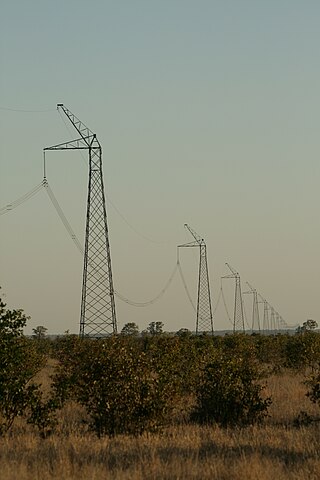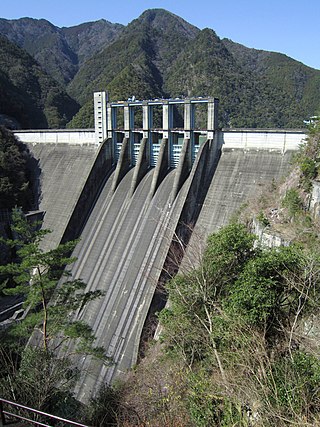
A high-voltage direct current (HVDC) electric power transmission system uses direct current (DC) for electric power transmission, in contrast with the more common alternating current (AC) transmission systems.

The HVDC Cross-Channel is the 73-kilometre-long (45 mi) high-voltage direct current (HVDC) interconnector that has operated since 1986 under the English Channel between the continental European grid at Bonningues-lès-Calais and the British electricity grid at Sellindge. The cable is also known as IFA, and should not be confused with the new IFA-2, another interconnect with France that is three times as long but only half as powerful.
The HVDC Inter-Island link is a 610 km (380 mi) long, 1200 MW high-voltage direct current (HVDC) transmission system connecting the electricity networks of the North Island and South Island of New Zealand together. It is commonly referred to as the Cook Strait cable in the media and in press releases, although the link is much longer than its Cook Strait section. The link is owned and operated by state-owned transmission company Transpower New Zealand.

The Pacific DC Intertie is an electric power transmission line that transmits electricity from the Pacific Northwest to the Los Angeles area using high voltage direct current (HVDC). The line capacity is 3.1 gigawatts, which is enough to serve two to three million Los Angeles households and represents almost half of the Los Angeles Department of Water and Power (LADWP) electrical system's peak capacity.

The Nelson River DC Transmission System, also known as the Manitoba Bipole, is an electric power transmission system of three high voltage, direct current lines in Manitoba, Canada, operated by Manitoba Hydro as part of the Nelson River Hydroelectric Project. It is now recorded on the list of IEEE Milestones in electrical engineering. Several records have been broken by successive phases of the project, including the largest mercury-arc valves, the highest DC transmission voltage and the first use of water-cooled thyristor valves in HVDC.
HVDC Kingsnorth was a high-voltage direct-current (HVDC) transmission system connecting Kingsnorth in Kent to two sites in London. It was at one time the only application of the technology of high voltage direct current transmission for the supply of transformer stations in a city, and the first HVDC link to be embedded within an AC system, rather than interconnecting two asynchronous systems. It was also the first HVDC scheme to be equipped with self-tuning harmonic filters and to be controlled with a "Phase Locked Oscillator", a principle which subsequently became standard on all HVDC systems.

Cahora-Bassa is an HVDC power transmission system between the Cahora Bassa Hydroelectric Generation Station at the Cahora Bassa Dam in Mozambique, and Johannesburg, South Africa.

The Inga–Shaba EHVDC Intertie is a 1,700 kilometres (1,100 mi)-long high-voltage direct current overhead electric power transmission line in the Democratic Republic of Congo, linking the Inga hydroelectric complex at the mouth of the Congo River to mineral fields in Shaba (Katanga). It was primarily constructed by Morrison-Knudsen International, an American engineering company, with the converter equipment supplied by ASEA. Construction was completed in 1982 and it cost US$900 million. The scheme was, for many years, the longest HVDC line in the world.

An HVDC converter station is a specialised type of substation which forms the terminal equipment for a high-voltage direct current (HVDC) transmission line. It converts direct current to alternating current or the reverse. In addition to the converter, the station usually contains:

A mercury-arc valve or mercury-vapor rectifier or (UK) mercury-arc rectifier is a type of electrical rectifier used for converting high-voltage or high-current alternating current (AC) into direct current (DC). It is a type of cold cathode gas-filled tube, but is unusual in that the cathode, instead of being solid, is made from a pool of liquid mercury and is therefore self-restoring. As a result mercury-arc valves, when used as intended, are far more robust and durable and can carry much higher currents than most other types of gas discharge tube. Some examples have been in continuous service, rectifying 50 ampere currents for decades.
The HVDC Itaipu is a High-voltage direct current overhead line transmission system in Brazil from the Itaipu hydroelectric power plant to the region of São Paulo. The project consists of two ±600 kV bipoles, each with a rated power of 3150 MW, which transmit power generated at 50 Hz from the Paraguay side of the Itaipu Dam to the Ibiúna converter station near São Roque, São Paulo. The system was put in service in several steps between 1984 and 1987, and remains among the most important HVDC installations in the world.

Path 27, also called the Intermountain or the Southern Transmission System (STS), is a high-voltage direct current (HVDC) electrical transmission line running from the coal-fired Intermountain Power Plant near Delta, Utah, to the Adelanto Converter Station at Adelanto, California, in the Southwestern United States. It was installed by the ABB Group, a company based in Switzerland, and commercialized in July 1986. The system is designed to carry power generated at the power plant in Utah to areas throughout Southern California. It is owned and operated by the Intermountain Power Agency, a cooperative consisting of six Los Angeles-area cities, the largest member being the Los Angeles Department of Water and Power (LADWP), and 29 smaller Utah municipalities.
The Eel River Converter Station is a high-voltage direct current (HVDC) converter station in Eel River Crossing, New Brunswick, Canada; it is the first operative HVDC station in the world equipped with thyristors.
The HVDC Rihand–Delhi is a HVDC connection between Rihand and Dadri in India, put into service in 1990. It connects the 3,000 MW coal-based Rihand Thermal Power Station in Uttar Pradesh to the northern region of India. The project has an 814 kilometres (506 mi) long bipolar overhead line. The transmission voltage is 500 kV and the maximum transmission power is 1,500 megawatts. The project was built by ABB.

The Celilo Converter Station, built in 1970 and owned and operated by the Bonneville Power Administration, is the northern terminus of the Pacific DC Intertie, near The Dalles, Oregon, in the United States.

The Sakuma Dam is a dam on the Tenryū River, located on the border of Toyone, Kitashitara District, Aichi Prefecture on the island of Honshū, Japan. It is one of the tallest dams in Japan and supports a 350 MW hydroelectric power station. Nearby a frequency converter station is installed, allowing interchange of power between Japan's 50 Hz and 60 Hz AC networks.
The Chandrapur–Padghe HVDC transmission system is an HVDC connection between Chandrapur and Padghe in the state of Maharashtra in India, which was put into service in 1999.
An HVDC converter converts electric power from high voltage alternating current (AC) to high-voltage direct current (HVDC), or vice versa. HVDC is used as an alternative to AC for transmitting electrical energy over long distances or between AC power systems of different frequencies. HVDC converters capable of converting up to two gigawatts (GW) and with voltage ratings of up to 900 kilovolts (kV) have been built, and even higher ratings are technically feasible. A complete converter station may contain several such converters in series and/or parallel to achieve total system DC voltage ratings of up to 1,100 kV.
The Rio Madeira HVDC system is a high-voltage direct current transmission system in Brazil, built to export power from new hydro power plants on the Madeira River in the Amazon Basin to the major load centres of southeastern Brazil. The system consists of two converter stations at Porto Velho in the state of Rondônia and Araraquara in São Paulo state, interconnected by two bipolar ±600 kV DC transmission lines with a capacity of 3,150 megawatts (4,220,000 hp) each. In addition to the converters for the two bipoles, the Porto Velho converter station also includes two 400 MW back-to-back converters to supply power to the local 230 kV AC system. Hence the total export capacity of the Porto Velho station is 7100 MW: 6300 MW from the two bipoles and 800 MW from the two back-to-back converters. When Bipole 1 commenced commercial operation in 2014, Rio Madeira became the world’s longest HVDC line, surpassing the Xiangjiaba–Shanghai system in China. According to the energy research organisation Empresa de Pesquisa Energética (EPE), the length of the line is 2,375 kilometres (1,476 mi).
The Xiangjiaba–Shanghai HVDC system is a ±800 kV, 6400 MW high-voltage direct current transmission system in China. The system was built to export hydro power from Xiangjiaba Dam in Sichuan province, to the major city of Shanghai. Built and owned by State Grid Corporation of China (SGCC), the system became the world’s largest-capacity HVDC system when it was completed in July 2010, although it has already been overtaken by the 7200 MW Jinping–Sunan HVDC scheme which was put into operation in December 2012. It also narrowly missed becoming the world’s first 800 kV HVDC line, with the first pole of the Yunnan–Guangdong project having been put into service 6 months earlier. It was also the world’s longest HVDC line when completed, although that record is also expected to be overtaken early in 2013 with the completion of the first bipole of the Rio Madeira project in Brazil.









